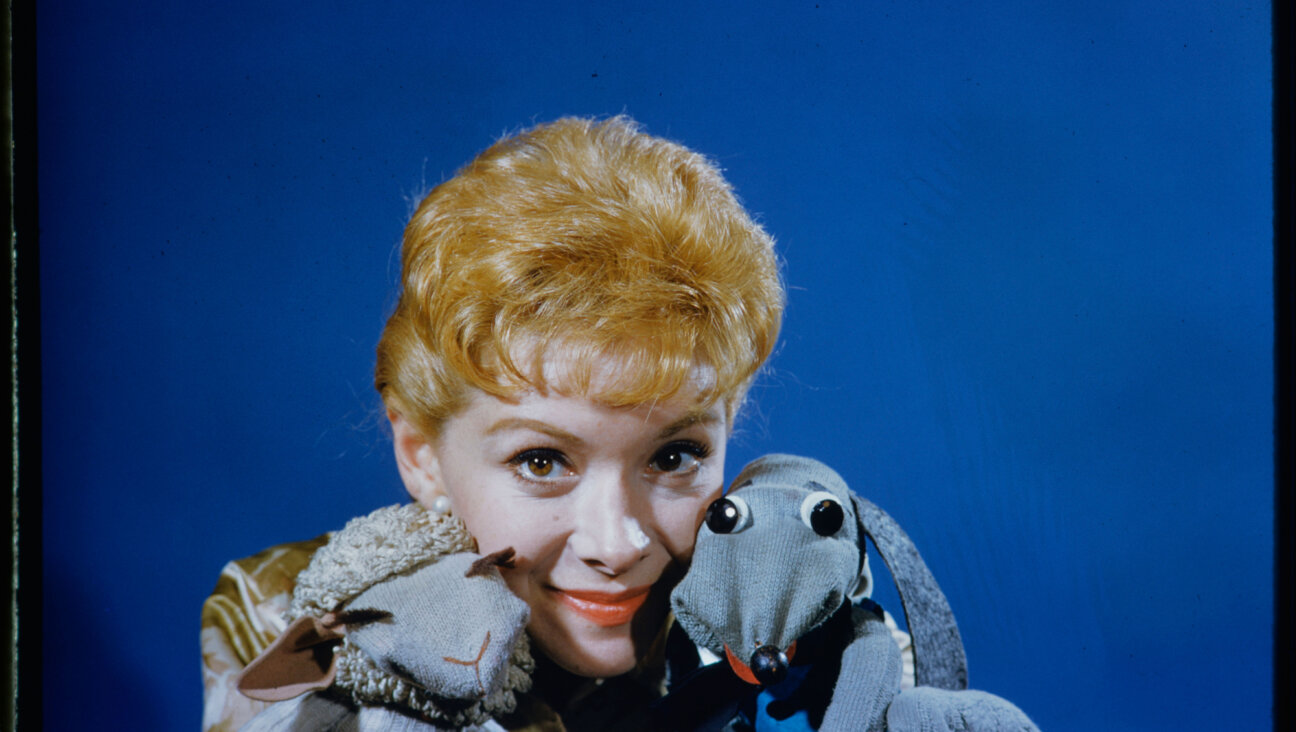An Honest Marriage of Vermont and Judaism

Graphic by Angelie Zaslavsky
A white-pillared converted stone church beside a coppice of pine trees and over a sloping meadow from the grave of poet Robert Frost, might seem like a strange location for a sukkah, but this fall the Bennington Museum hosted two of them to mark the centennial of organized Judaism in the Vermont town.

Woodwork: An interior view of Emmett Leader?s sukkah, which cel- ebrates the centennial of organized Judiasm in Bennington, Vt. Below, Tzedakah Box (Birds) 2008. Image by JOHN POLAK
Members of the local Congregation Beth El erected a timber-frame sukkah, which they also used to celebrate the holiday, on the museum’s wooded hillside.
Its counterpart appeared in the museum’s second-floor gallery as a part of artist Emmett Leader’s exhibit, Revisiting Traditions — Illuminating Our Times, which closed on November 8. Made of salvaged wood, and decorated with a lulav and a clay figurine of the artist’s father riding an Allis-Chalmers tractor, this ornamental sukkah highlighted the exhibit’s meditation on the complexities of making a Jewish home in rural New England.
Though the Hebrew Congregation of Bennington first associated in 1909 as part of the Orthodox movement, it took an additional 14 years to put up a synagogue. A decline began in the 1970s, as the older generation retired and the younger one moved away. In 1988, members were unable to gain access to a dilapidated Beth El over the High Holy Days, and they resolved to revitalize the community and renovate the building.
The synagogue has since affiliated Reconstructionist, and its membership has grown to 110 families, the result of an effort to reach out to a scattered Jewish polity making up no more than 1% of the state’s total population.
“No one moves to Vermont to be a part of the Jewish community,” said Beth El’s rabbi, Joshua Boettiger. “But these off-the-beaten track communities can be creative experiments in what it means to be Jewish.”
Boettiger’s own rustic background includes certification as a timber-frame carpenter, an older method of woodwork that relies on the joining of carved posts and beams in place of the nail-intensive methods of stud-carpentry. (He is also the great-grandson of Franklin Delano Roosevelt, and has been called upon to reflect on Roosevelt’s relationship to the Jews.) Boettiger co-led a workshop in September that culminated in the raising of the sukkah on museum grounds, a blending of traditions he called “an honest marriage of Vermont and Judaism.”
It was also a milestone in Beth El’s yearlong centennial observances, which will soon conclude with the rededication of the synagogue’s building at Hanukkah, symbolizing the community’s renewed commitment to cultivating Jewish life in this improbable locale. The festivities have already featured a class on the counting of the Omer, a reading by novelist Jamaica Kincaid (a congregation member) and, as the centerpiece, Leader’s exhibit.
Leader has deep roots in Jewish Bennington. His grandfather, Rabbi Isaac Leader, arrived in 1908, having emigrated from the shtetl of Slonim, and played a significant role in establishing the community. Emmett Leader grew up on a family farm in nearby Andover, developing a deep connection to Vermont’s landscape and sensibility, and ambivalence toward his family’s attenuated Judaism. He eventually left Vermont in his late 30s and moved to central Massachusetts to participate in a more cohesive Jewish lifestyle. Revisiting Traditions represented a double homecoming: not only a physical return, but also an artistic synthesis of two parts of his identity.
Clay-fashioned Judaica and pictorial terra cotta tiles were clustered around three larger installations that Leader described as “homes I felt a very strong urge to make.” Along with the sukkah, there was a partial re-creation of a wooden Russian synagogue, called “Slonim Revisited,” and a dovecote inhabited by such family artifacts as letters, photographs and his grandfather’s shechitah (kosher slaughter) knives, as opposed to the pigeons that normally dwell in these structures. It hearkened back to the huddle of buildings on Vermont homesteads that captured Leader’s imagination when he was a child.
“Barns influenced who I am,” he said. “You’d look up and realize they were made over a hundred years ago, and see the purpose and ambition. They were like cathedrals.”
Discovering an analogous handicraft tradition in the annals of Eastern European Judaism, particularly the wooden synagogues he found through the scholarship of architectural historian Thomas Hubka, enabled Leader to derive his own rural Jewish vernacular.
“I got the same sense of awe from these shuls,” he said, “as when I went into a barn…When I saw this folk culture that was Jewish, it just gave me a green light.”
Leader’s symbolic language was poignantly employed in a triptych, “My Grandfather’s Rabbinate,” depicting the true story of Isaac Leader’s Vermont metamorphosis from rabbi to meat market operator and, allegedly, hog butcher. Though his grandfather died long before Emmett Leader was born, the specter of the man, both closer to a primal Judaism and guilty of corrupting his ways, has long preoccupied the artist. This particular piece, drawing on the iconography of the medieval “Birds’ Head Haggadah” and set against a backdrop that could be Andover or Anatevka, conceived a generous resolution: the Green Mountains as a place not of ultimate loss, but of inevitable wandering perhaps leading to renewed vision.
Standing in Leader’s version of Slonim’s wooden synagogue, an exploration of Jewish material culture conditioned by a rural American upbringing, Boettiger suggested that Vermont Jews might have a unique receptivity to the Jewish past.
“In some ways,” he said, “we’re closer to the shtetl. Maybe we’re freer to embrace aspects of Jewish culture that aren’t as intuitive in cities and suburbs.”
Leader, who will be exhibiting his work next fall at Hebrew Union College-Jewish Institute of Religion in New York City, concurred.
“Judaism doesn’t always grow from the center,” he said. “Sometimes it comes from the edges.”
Benjamin Weiner is a writer and rabbi living in Boston.





















